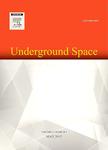Vibration transfer from underground train to multi-story building:Modelling and validation with in-situ test data
作者机构:Section of Railway EngineeringDelft University of TechnologyStevinweg 12628CN DelftThe Netherlands Key Laboratory of High-speed Railway Engineering(Southwest Jiaotong University)Ministry of EducationChengdu 610031China
出 版 物:《Underground Space》 (地下空间(英文))
年 卷 期:2024年第19卷第6期
页 面:301-316页
核心收录:
基 金:School of Civil Engineering and Geomatics Southwest Petroleum University, SWPU
主 题:Railway vibration Underground train Multi-story building vibration Finite element model Dynamic interaction
摘 要:Excessive underground train-induced vibration becomes a serious environmental problem in *** investigate the vibration transfer from an underground train to a building nearby,an explicit-integration time-domain,three-dimensional finite element model is *** underground train,track,tunnel,soil layers and a typical multi-story building nearby are all fully coupled in this *** complex geometries involving the track components and the building are all modelled in detail,which makes the simulation of vibration transfer more realistic from the underground train to the *** model is validated with in-situ tests data and good agreements have been achieved between the numerical results and the experimental results both in time domain and frequency *** proposed model is applied to investigate the vibration transfer along the floors in the building and the influences of the soil stiffness on the vibration characteristics of the track-tunnel-soil-building *** is found that the building vibration induced by an underground train is dominant at the frequency determined by the P2 resonance and influenced by the vibration modes of the *** vertical vibration in the building decreases in a fluctuant pattern from the foundation to the top floor due to loss of high frequency contents and local *** vibration levels in different rooms at a same floor can be different due to the different local stiffness.A room with larger space thus smaller local stiffness usually has higher vibration *** soil layers make the tunnel lining and the building have more low frequency *** influence of the soil stiffness on the amplification scale along the floors of the building is found to be nonlinear and frequency-dependent,which needs to be further investigated.



